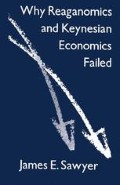Abstract
Ronald Reagan came to power with a mandate to purge the economy of the ills of Keynesianism. Since the Federal Reserve had already begun the task a full year ahead of the Republican landslide of 1980, momentum was well under way. Among the architects of the laissez-faire resurgence, or ‘supply-siders’, was Arthur Laffer who argued for a reduction in tax rates. According to the supply-siders, a cut in tax rates would stimulate output and income, and therefore generate a larger federal base from which tax revenues could be drawn. So even though rates might be cut, the end result would be an increase in total tax revenues.
Access this chapter
Tax calculation will be finalised at checkout
Purchases are for personal use only
Preview
Unable to display preview. Download preview PDF.
Author information
Authors and Affiliations
Copyright information
© 1987 James E. Sawyer
About this chapter
Cite this chapter
Sawyer, J.E. (1987). Reaganomics. In: Why Reaganomics and Keynesian Economics Failed. Palgrave Macmillan, London. https://doi.org/10.1007/978-1-349-09497-4_11
Download citation
DOI: https://doi.org/10.1007/978-1-349-09497-4_11
Publisher Name: Palgrave Macmillan, London
Print ISBN: 978-1-349-09499-8
Online ISBN: 978-1-349-09497-4
eBook Packages: Palgrave Economics & Finance CollectionEconomics and Finance (R0)

